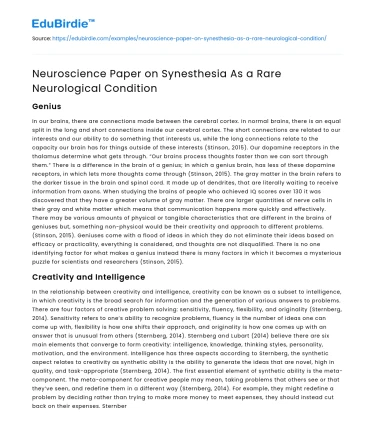Introduction
Synesthesia is a fascinating and rare neurological condition characterized by the blending of sensory experiences. Individuals with synesthesia, known as synesthetes, may perceive colors when they hear music, or taste flavors when reading words. This cross-wiring of the senses, although once considered a mere curiosity, has gained significant attention in recent years within the field of neuroscience. The prevalence of synesthesia is estimated to range from 0.05% to 4% of the population, indicating its rarity and the complexity of its underlying mechanisms. This essay aims to explore the etiology, manifestations, and implications of synesthesia, drawing on scientific studies, real-life cases, and theoretical counter-arguments to provide a comprehensive understanding of this intriguing condition. By examining the neurological basis and cognitive implications of synesthesia, we seek to highlight its importance in the broader context of sensory perception and brain function.
Neurological Basis of Synesthesia
The neurological basis of synesthesia has been a topic of considerable research, with studies suggesting that it results from atypical neural connectivity. The most widely accepted hypothesis posits that synesthesia arises from increased cross-activation between adjacent sensory regions in the brain. For instance, in grapheme-color synesthesia, where letters or numbers are perceived as inherently colored, there is evidence of increased connectivity between the visual cortex and the areas responsible for color processing. A study by Ramachandran and Hubbard (2001) utilized functional magnetic resonance imaging (fMRI) to demonstrate such cross-activation, providing concrete evidence of this neural phenomenon.
Save your time!
We can take care of your essay
- Proper editing and formatting
- Free revision, title page, and bibliography
- Flexible prices and money-back guarantee
Moreover, genetic factors are believed to play a role in the development of synesthesia. Research has identified potential genetic markers associated with synesthetic experiences, suggesting a hereditary component. As Asher et al. (2009) indicate, synesthesia often runs in families, implying that genetic predispositions may influence the likelihood of developing the condition. However, the precise genetic mechanisms remain elusive, warranting further investigation. Despite the progress in understanding synesthesia's neurological underpinnings, some scholars argue that synesthesia may not solely be the result of neural cross-wiring. They suggest that environmental factors and early developmental experiences could also contribute to the manifestation of synesthetic perceptions. This counter-argument underscores the multifaceted nature of synesthesia and the need for interdisciplinary research to unravel its complexities.
Manifestations and Types of Synesthesia
Synesthesia manifests in various forms, each offering unique insights into sensory perception. The most commonly reported type is grapheme-color synesthesia, where individuals associate specific colors with letters and numbers. Another prevalent form is chromesthesia, where sounds involuntarily evoke the perception of colors. Renowned composer Olivier Messiaen famously experienced chromesthesia, which influenced his musical compositions, illustrating how synesthesia can impact creative expression. Additionally, lexical-gustatory synesthesia involves tasting words, a rare form that has been documented in case studies such as that of James Wannerton, who reported distinctive tastes associated with different words.
These diverse manifestations highlight the individualized nature of synesthetic experiences. The subjective quality of synesthesia challenges traditional notions of sensory perception, prompting researchers to explore its cognitive implications. Studies have shown that synesthetes often exhibit enhanced memory and creativity, suggesting that the condition may confer certain cognitive advantages. However, the subjective nature of synesthetic experiences also raises questions about their reliability and validity. Critics argue that synesthesia may be a construct of heightened imagination rather than a true sensory phenomenon. This skepticism encourages continued empirical research to validate synesthetic experiences and understand their broader implications.
Implications and Future Directions
The implications of synesthesia extend beyond individual experiences to broader questions about brain function and perception. Understanding synesthesia provides valuable insights into sensory integration and the brain's ability to process complex stimuli. The study of synesthesia has also led to advancements in artificial intelligence and machine learning, where algorithms inspired by synesthetic principles are being developed to enhance sensory processing capabilities. Moreover, synesthesia challenges traditional boundaries between the senses, prompting a re-evaluation of how sensory information is represented and integrated in the brain.
As we advance our understanding of synesthesia, it is crucial to consider its potential applications in clinical settings. Exploring synesthetic experiences may offer new approaches to sensory rehabilitation and cognitive enhancement therapies. However, achieving these applications requires a deeper understanding of the neural mechanisms and cognitive processes underlying synesthesia. Future research should focus on longitudinal studies to track the development and progression of synesthetic experiences over time, as well as cross-disciplinary collaborations to explore the intersection of synesthesia, art, and technology. By embracing synesthesia as a window into the complexities of sensory perception, neuroscience can continue to unravel the mysteries of the human brain.
Conclusion
In conclusion, synesthesia represents a unique intersection of sensory modalities, offering profound insights into the brain's capacity for integration and perception. While its rarity and complex etiology present challenges, ongoing research continues to shed light on the neurological and cognitive underpinnings of this condition. By examining both supporting evidence and counter-arguments, we gain a holistic understanding of synesthesia's implications for neuroscience and beyond. As we deepen our exploration of this intriguing phenomenon, synesthesia not only enriches our knowledge of sensory processing but also inspires innovative approaches to cognitive science and artificial intelligence. The continued study of synesthesia promises to unlock new dimensions of understanding, fostering a greater appreciation for the intricate workings of the human mind.






 Stuck on your essay?
Stuck on your essay?

